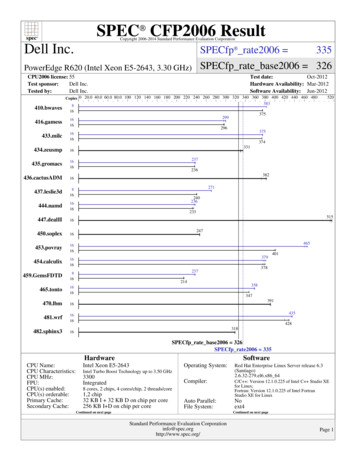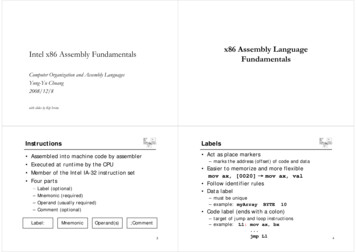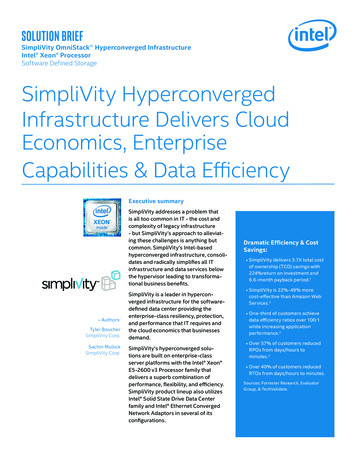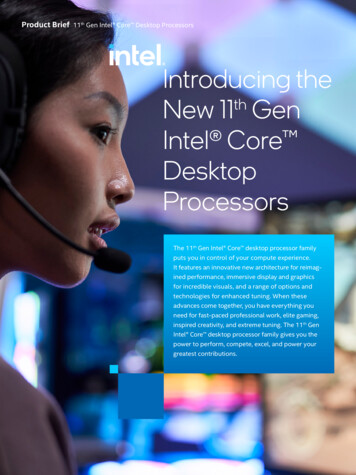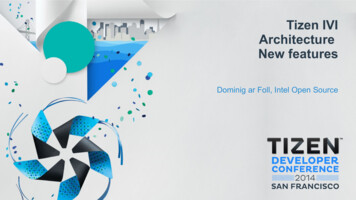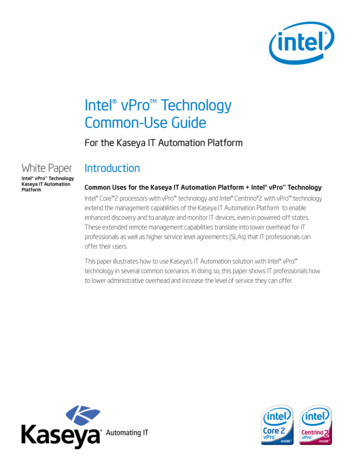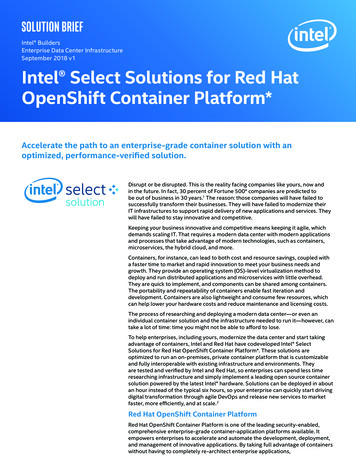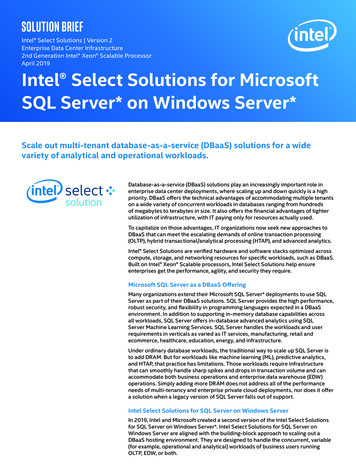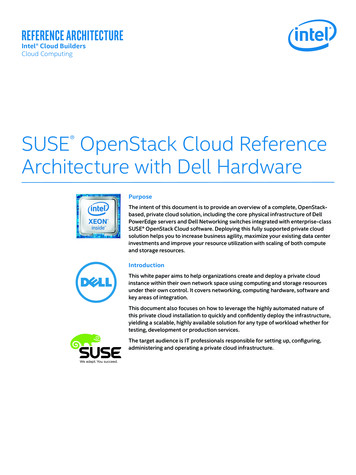
Transcription
REFERENCE ARCHITECTUREIntel Cloud BuildersCloud ComputingSUSE OpenStack Cloud ReferenceArchitecture with Dell HardwarePurposeThe intent of this document is to provide an overview of a complete, OpenStackbased, private cloud solution, including the core physical infrastructure of DellPowerEdge servers and Dell Networking switches integrated with enterprise-classSUSE OpenStack Cloud software. Deploying this fully supported private cloudsolution helps you to increase business agility, maximize your existing data centerinvestments and improve your resource utilization with scaling of both computeand storage resources.IntroductionThis white paper aims to help organizations create and deploy a private cloudinstance within their own network space using computing and storage resourcesunder their own control. It covers networking, computing hardware, software andkey areas of integration.This document also focuses on how to leverage the highly automated nature ofthis private cloud installation to quickly and confidently deploy the infrastructure,yielding a scalable, highly available solution for any type of workload whether fortesting, development or production services.The target audience is IT professionals responsible for setting up, configuring,administering and operating a private cloud infrastructure.
Cloud Computing White Paper: SUSE OpenStack Cloud Reference Architecture with Dell HardwareTable of ContentsSolution FocusSolution Focus . . . . . . . . . . . . . . . . . . . . . 2Through integrated, open sourcesoftware, enterprises can establish anInfrastructure-as-a-Service (IaaS1) private cloud that delivers on-demand access to pools of compute, storage andnetworking resources for use withintheir organization. These resources areprovisioned as necessary to meet thespecific requirements of the applications and services deployed in thecloud. Compute resources are providedthrough the provisioning of physicalservers or virtual machines running ontop of a hypervisor. Providing storageresources can be accomplished witheither dedicated storage elements orvia distributed, resilient file systemsacross industry-standard hardwarewith local storage devices. Networking provides the unifying connectivity that ties the compute, storage andmanagement elements of the privatecloud together. Given the complexityof such an infrastructure, the networkmust be provided in a fully configurablefashion, adapting to change requestson demand. Finally, it is the privatecloud software that provides the userinterface for setup, configuration andmaintenance as well as the long-termoperation of the cloud by bondingthese three core components into acohesive service offering.Background. . . . . . . . . . . . . . . . . . . . . . . . 2Approach . . . . . . . . . . . . . . . . . . . . . . . . . . 2Site Preparation Needed for theDeployment. . . . . . . . . . . . . . . . . . . . . . . . 3Facility Considerations . . . . . . . . . . . 3Networking Considerations . . . . . . . 4Computing PlatformConsiderations. . . . . . . . . . . . . . . . . . . 4Software ComponentConsiderations. . . . . . . . . . . . . . . . . . . 5Administration Server . . . . . . . . . . . . 5Control Node(s) . . . . . . . . . . . . . . . . . . 5Compute Node(s). . . . . . . . . . . . . . . . . 6Storage Node(s). . . . . . . . . . . . . . . . . . 6Instance Sizing Guidelines . . . . . . . . 7Solution . . . . . . . . . . . . . . . . . . . . . . . . . . . 8Network . . . . . . . . . . . . . . . . . . . . . . . . . 8Computing Hardware. . . . . . . . . . . . 10Software. . . . . . . . . . . . . . . . . . . . . . . . 10Software DeploymentDecisions . . . . . . . . . . . . . . . . . . . . . . . 10Control Node(S) Setup &Configuration . . . . . . . . . . . . . . . . . . . 14Compute Node(S) Setup &Configuration . . . . . . . . . . . . . . . . . . . 14Storage Node(S) Setup &Configuration . . . . . . . . . . . . . . . . . . . 15Openstack Services Setup &Configuration . . . . . . . . . . . . . . . . . . . 15Summary . . . . . . . . . . . . . . . . . . . . . . . . . 16Support. . . . . . . . . . . . . . . . . . . . . . . . . . . 16Appendices . . . . . . . . . . . . . . . . . . . . . . . 16Rack and Power . . . . . . . . . . . . . . . . . 16Networking Switches . . . . . . . . . . . . 16Computing Platform. . . . . . . . . . . . . 22Software. . . . . . . . . . . . . . . . . . . . . . . . 311http://en.wikipedia.org/wiki/Infrastructure as a oducts/cloud-managerBackgroundCloud computing delivers access toresources like hardware and softwareover a network, abstracting the complex, internal infrastructures fromend users and, to an extent, fromsome development and informationtechnology operational professionals(DevOps). It allows individual virtualmachines or workloads to be provisioned on demand from predefined2templates with little concern about theunderlying infrastructure or resources.Services, consisting of many workloads,can be provisioned for use in minutesand then scaled appropriately to meetservice demands. For further reference,the National Institute of Standards andTechnology’s (NIST) Definition of CloudComputing2 describes the importantcharacteristics of cloud computing.While public cloud services haveexisted for some time, a private cloudenables companies to take advantageof the benefits of cloud computingwith less risk of data exposure andmore control of resources because it isoperated behind the corporate firewall.However, compared to public clouds,private clouds impact capital costsaving profiles because they continueto require investment in locally maintained infrastructure. Yet, becauseprivate cloud resources can be sharedvia higher levels of automation, they offer potentially higher overall utilizationwith the total cost of ownership likelylower than traditional IT infrastructure deployment change requests ondemand.ApproachThis white paper provides a completeprivate cloud solution including the corephysical infrastructure and enterpriseready versions of many open sourceofferings. With this framework, enterprises can take a secure approach toincrease agility, enhance scalability andimprove utilization of resources. Such aprivate cloud instance can even be integrated with or extended to public cloudresources with the Dell Cloud Manager3product, enabling the provisioning,automation and management of workloads across this hybrid cloud approach.Conceptually, the basic building blocks
Cloud Computing White Paper: SUSE OpenStack Cloud Reference Architecture with Dell Hardware3End UsersAPIsSelf Ser vice PortalAutomated Configuration Optimized DeploymentAPIsPool of Virtualized ServersImage Repository(Compute and Storage Nodes)Figure 1: Infrastructure-as-a-Service (IaaS) private cloud deploymentfor deploying a private cloud (i.e.,networking infrastructure, computinghardware and software) are similar toany IT infrastructure.With private clouds, delivering robustnetwork resources for the core infrastructure and the needs of the workloads requires significant attention.High-speed, scalable devices likethe Dell Network Managed S-seriesof network switches and modern,industry-standard x86-based servers like the Dell PowerEdge R Serversprovide an ideal platform for privateclouds because they balance performance and efficiency. The emergingsoftware standard for private cloudimplementations is the open sourceLinux operating system. The currentreference framework for the clouditself, OpenStack4, is also open source,as are many cloud sub-components.Examples include KVM or Xen virtualization technologies and Crowbar, anopen source project founded by Pwhich facilitates system deploymentand enables scaling with the privatecloud instance. These open sourcecomponents deliver an overall privatecloud ecosystem that yields a completely functional, usable and stableinstallation today. In addition, the rapidinnovation of open source development will continue to rapidly enhancecurrent features and add capabilities. The figure below illustrates all ofthese components and interactions todeliver an Infrastructure-as-a-Service(IaaS) private cloud deployment: Thiswhite paper introduces the setup andconfiguration of networking servicesfor a private cloud instance using ultralow latency Dell Networking top-ofrack (ToR) switches as the networkinginfrastructure, Dell PowerEdge serversfor both compute and storage resources and SUSE OpenStack Cloud5 as theprivate cloud software.For the remainder of this document,the user should refer to the documentation for the specific network andcomputing hardware and softwareproducts under discussion, using thiswhite paper as supplemental information to augment, clarify and furtherrefine the use of the other documentation for a successful deployment.Site Preparation Needed for theDeploymentFacility ConsiderationsThe heating, ventilation, air conditioning (HVAC) and power requirementsfor deployment can be estimatedusing the Dell Energy Smart SolutionAdvisor6. Using this tool, you can planthe needs for your solution, order thecorrect Power Distribution Unit (PDU)and have the proper HVAC ready forthe installation.This white paper does not specifyany country-specific localization orPDU since power requirements varydepending on the exact configurationand the power configuration in thefinal installation location.
Cloud Computing White Paper: SUSE OpenStack Cloud Reference Architecture with Dell HardwareNetworking ConsiderationsBecause networking is the technology component likely to take the mostupfront planning, networking requirements for a private cloud instance havea fair amount of complexity, especiallywhen integrated with an existing ITinfrastructure. For the physical level,use a pair of Dell Networking S40487top-of-rack (ToR) 10GbE with 40GbEuplinks connected together withVirtual Link Trunking (VLT). These DellNetworking switches offer an ultralow-latency switch fabric providingnon-blocking performance. To complete the fabric, a single Dell Networking S30488 switch is used to handle the1GbE connections from the dedicatedBMC/iDRAC ports of each resourcenode and is uplinked to both of theS4048 switches for redundancy. Witheach server having multiple NIC ports,forming a bonded link across the portswith at least one port on each switch inthe stack provides both performanceand redundancy across the multipleNIC and switch configuration. The appendices include the recommendedconfiguration for each of these DellNetworking switches plus the types ofcables to include in an order.Computing Platform ConsiderationsOne of the benefits of a private cloudimplementation is that industry-standard servers can fulfill all the needs.4To reduce the time spent on hardwarespecification for an initial privatecloud implementation, the hardwareshould be general purpose and allowfor a wide range of configuration options. The popular Dell PowerEdgeR4309, R63010, R73011 and R730xd12series of servers with their powerfuland balanced performance, advancedI/O capabilities and flexible, scalablenetworking options are ideally suitedfor all the various nodes in this privatecloud installation reference configuration . The appendices contain therecommend ed configurations for eachof these system platforms with a preferred model for each of the variousprivate cloud node roles.NETWORK NAMENETWORK DESCRIPTION/CONSIDERATIONSAdminPrivate network to access the Administration Server and all nodes for administration purposes. The defaultsetup lets you also access and manage any available BMC (Baseboard Management Controller) data via IPMI(Intelligent Platform Management Interface) from this network. If required, BMC access can be utilized on aseparate network. You have the following options for controlling access to this network: Do not allow access from the outside and keep the admin network completely separated. Allow access to the Administration Server from a single network (for example, your company’s administrationnetwork) via the “bastion network” option configured on an additional network card with a fixed IP address. Allow access from one or more networks via a gateway.Storage VLAN:200 Private SUSE Cloud internal virtual network. This network is used by Ceph and OpenStack Object Store (Swift)only. It should not be accessed by users.PublicThe only public network provided by SUSE OpenStack Cloud. You can access the OpenStack Dashboard(Horizon) and all workload instances (provided they have been equipped with a floating IP) via this network. Youhave the following options for controlling access to this network:(nova-floating)VLAN:300 This network can be accessed only by a gateway, which needs to be provided externally. All SUSE OpenStack Cloud users and administrators need to be able to access the public network. The two functions can be split, if so desired, to address security concerns, so that the OpenStack Dashboardand APIs are assessable from on range and the floating IPs assigned to the workload are in another networkrange.Software DefinedNetwork (os sdn)VLAN:400Private SUSE Cloud internal virtual network. This network is used when OpenStack Networking (Neutron) isconfigured to use Open vSwitch with GRE tunnelling for the virtual networks. It chould not be accessed by users.PrivatePrivate SUSE OpenStack Cloud internal virtual network. This network is used for inter-instance communicationsand provides access to the outside world for the instances. The gateway required is also automatically providedby SUSE OpentStack Cloud.(nova-fixed) /pd
Cloud Computing White Paper: SUSE OpenStack Cloud Reference Architecture with Dell HardwareSoftware Component ConsiderationsSUSE OpenStack Cloud provides theenterprise-grade implementation ofOpenStack components and includesother tools for a complete private cloudimplementation. Fundamental to aprivate cloud implementation, variousnetworks are needed to manage, operate, access and provide isolation for allthe components and services. SUSEOpenStack Cloud utilizes the followingset of network namespaces:SUSE OpenStack Cloud forms the basisof the IaaS private cloud operatingsolution and overall framework to abstract the network, computing and storage resources by including a number ofOpenStack projects, components andservices, as shown in the table below.Based upon the previously describednetwork namespace model and thevarious OpenStack services, multiplephysical hosts are required for the various server roles in a SUSE OpenStackCloud implementation:Administration Server Usually the first system installed, theSUSE OpenStack Cloud Administration Server is a dedicated systemthat provides all services needed toset up and deploy all other resourcenodes in the private cloud installation. It runs on the SUSE LinuxEnterprise Server operating systemand provides the deployment framework with the Crowbar deploymentengine along with other tools. Amongthe services p rovided to the cloudinstance by this server are DHCP,DNS, NTP, PXE and TFTP. These components are set up, configured andaccessed from a web interface thatguides all the r emaining installationand configuration tasks through theuse of barclamps.5 The Administration Server also commonly hosts the n ecessary softwarerepositories for SUSE Linux Enterprise Server and SUSE OpenStackCloud, along with other s oftwareproducts, since they are neededto deploy the Control, Computeand Storage Nodes. The remaining Control, Compute and StorageNodes are all provisioned by simplyPXE network booting from the SUSEOpenStack Cloud AdministrationServer. The primary user of this nodeand its web interface is the cloudadministrator.Control Node(s) A SUSE OpenStack Cloud ControlNode hosts the entire core OpenStack services needed to orchestratevirtual machines deployed on theCompute and utilizing volumes fromthe Storage Nodes in the privatecloud installation. Like the SUSEOPENSTACK PROJECTS: COMPONENTS & SERVICESOPENSTACK SERVICEPROJECTNAMEDashboardHorizonProvides a web-based, self-service portal to interact with underlying OpenStack services,such as launching an instance, assigning IP addresses and configuring access controls.ComputeNovaManages the lifecycle of compute instances in an OpenStack environment. Responsibilitiesinclude spawning, scheduling and decommissioning of virtual machines on demand.NetworkingNeutronEnables network-connectivity-as-a-service for other OpenStack services, such as OpenStackCompute. Provides an API for users to define networks and the attachments into them. Has apluggable architecture that supports many popular networking vendors and technologies.Object storageSwiftStores and retrieves arbitrary unstructured data objects via a RESTful, HTTP based API. It ishighly fault tolerant with its data replication and scale-out architecture. Its implementationis not like a file server with mountable directories. In this case, it writes objects and files tomultiple drives, ensuring the data is replicated across a server cluster.Block storageCinderProvides persistent block storage to running instances. Its pluggable driver architecturefacilitates the creation and management of block storage devices.Identity serviceKeystoneStores and retrieves virtual machine disk images. OpenStack Compute makes use of thisduring instance provisioning.Image serviceGlanceStores and retrieves virtual machine disk images. OpenStack Compute makes use of thisduring instance provisioning.TelemetryCeilometerMonitors and meters the OpenStack cloud for billing, benchmarking, scalability and statisticalpurposes.OrchestrationHeatOrchestrates multiple composite cloud applications by using either the native HOT templateformat or the AWS Cloud Formation template format, through both an OpenStack-nativeREST API and a Cloud Formation-compatible Query API.Application ProgrammingInterfaces (API)OpenStackAPIProvides application programing interfaces for block storage, compute, identity, imageservices, networking and other OpenStack components.DESCRIPTION
Cloud Computing White Paper: SUSE OpenStack Cloud Reference Architecture with Dell HardwareOpenStack Cloud AdministrationServer, it runs on the SUSE LinuxEnterprise Server operating system.It is managed and deployed throughthe SUSE OpenStack Cloud Administration Server web interface.TIP: For high availability setups,creating multiple dedicated ControlNodes is required with at least onepair of nodes needed for a cluster,yet an odd number is preferred to establish and maintain a quorum.Once a cluster is established, viathe Pacemaker barclamp, it can beassigned to many of the core OpenStack services. This document willdescribe the setup of a three-nodecluster of Control Nodes, but othercombinations are supported as notedin the d eployment guide. A particularly noteworthy service,the OpenStack Dashboard (Horizon)usually runs on the Control Node andgives users and administrators of theprivate cloud the ability to i nteractwith, deploy and manage their workloads and storage volumes.Compute Node(s) A SUSE OpenS
based, private cloud solution, including the core physical infrastructure of Dell PowerEdge servers and Dell Networking switches integrated with enterprise-class SUSE OpenStack Cloud software. Deploying t


